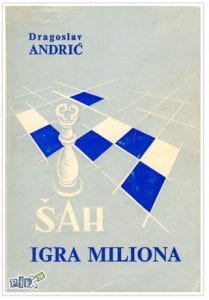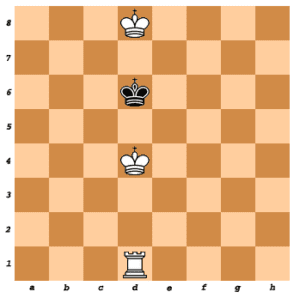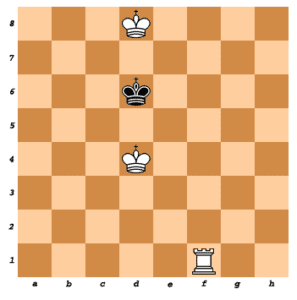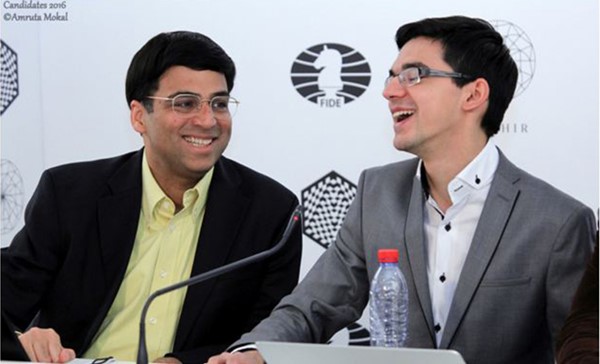Funny chess problems?
One of the greatest young chess talents in the World, 12-year-old International Master Nihal Sarin recently visited the quarters of the Chessbase in Hamburg, Germany.

In the article report following that visit, there was a number of funny chess problems whose solutions really made me smirk more than once.
And I immediately reminisced the similar delightful problems I’ve stumbled upon in the ancient chess book by Yugoslav Master Dragoslav Andrić : Šah – Igra Miliona (eng. Chess – The game of the millions).
I know that people don’t usually associate the word “funny” with the word “chess problem”.
However, I hope that this article will change your opinion. And that at least one of the problems will make you laugh.
In contrast to the most of the jokes on this blog.

The definition of the promotion rule
I would like to start with the summary of the set of problems given by the Nihal Sarin from the aforementioned article.
The problems revolved around the correct definition of the promotion rule.
The most common definition, also used by the author of these lines (cf. Basic chess rules) typically goes along the following lines:
“When the pawn reaches the last rank, a player can promote it to a piece of his choice.”
Nihal effectively refuted this definition with the following puzzle:
It is White to play and mate in three.
The only move that satisfies this condition is the surprising underpromotion… to a king:
1 d8K!!

The Black King is caught in a web of Kings. Wherever he goes, he gets caught by the rook
1… Ke6 2 Rf1 Kd6

White completes the checkmate with 3 Rf6. It is obvious that running to the c-file on the first move makes no difference (1… Kc6 2 Rb1!).
This little puzzle has pointed out a massive oversight in the initial definition. We can correct it here:
“When the pawn reaches the last rank, a player can promote it to a piece of his choice, except for a king.”
This definition is complete enough and shouldn’t lead to any confusion right?
Time for another problem:
Once again it is White to play and mate in three.
At first sight, the solution seems kinda obvious. White plays 1 f8Q with the idea of 2 Kh7 and 3 Qxh6 with checkmate.
However, 1 f8Q g2 2 Kh7 g3 and White probably even loses.
The move 1f8N!? is the next move that comes to mind. The idea is 2 Nh7 and 3 Nf6.
However, a cold shower once again awaits White, because 1f8N Bf1 2 Nh7 Rh2 and the king escapes.
However, White has the ingenious:
1 f8?
White leaves the pawn unpromoted for the moment. He is intending to promote the pawn on the next move after Black has made his move.
Thus on 1… Bf1 he chooses the queen and plays 2 Kh7
And on 1… g2 he chooses the knight and plays 2 Nh7
The reader might argue that this was cheating, but if we consider the formulation of the promotion rule, it technically wasn’t.
Therefore:
“When the pawn reaches the last rank, a player can promote it on the same move to a piece of his choice, except for a king”
If you think this settles everything, you’re in for another surprise.
Let’s take a look at the final diagram of this section:
White to play and mate in two moves.
After realising that tries such as 1 Qd5 or 2 Kd5 fail in the task, you hopefully went for the
1 Qb8+! Rxb8 2 axb8R (Black)
Pretty cheeky right 😀
Finally, after these three steps, we’ve arrived at the correct definition of the promotion rule. The formulation here is taken from the FIDE handbook (it seems that FIDE officials sometimes know what they are doing):
“3.7 e: When a player, having the move, plays a pawn to the rank furthest from its starting position, he must exchange that pawn as part of the same move for a new queen, rook, bishop or knight of the same colour on the intended square of arrival.”
To conclude this section, there is another funny little problem:
White to play and mate in one.
I will not post the solution to this one, but I hope that finding it won’t present a real difficulty when Nihal’s problems are still fresh in your head.
If you wish, you can post your solution in the comment section below 🙂
Charles the XII against the Turks
Way back in 1671, king Charles the XII was playing chess against his general Grothauzern while waiting for the news about the battle his army fought against the Turks on the nearby battlefield.
In the game, the following position has been reached:
Here, White can announce mate in three moves.
1 Rxg3! Bxg3 2 Nf3 Bplays 3 g4
However, before Charles played his move, the Turks shot a cannonball which flies over the board and takes the White Knight with it.
(I guess it must have been a really small cannonball… or a rather big chessboard).
Therefore, now the position is following:
After some thought, Charles announces mate in four moves:
1 hxg3 Be3 2 Rg4 Bg5 3 Rh4+! Bxh4 4g4
However, even before he could take the h-pawn and execute the combination, another cannonball arrives and takes the very h-pawn off the board as well.
Charles, not losing his composure, finds a mate in five moves and even manages to perform it:
1 Rb7 Bg1 (preparing an answer against Rh1) 2 Rb1 Bh2 3 Re1 Kh4 4 Kg6 Bg1 5 Re4
However, this is not the end of the story. According to the legend, the general, pretty angry at the moment, said that Charles was lucky because the first Turkish cannonball hit the Knight and not the rook.
“In that case, I would have mated you in six moves”, said Charles calmly.
1 Nf3 Be1 (on any other reply Black gets mated faster) 2 Nxe1 Kh4 3 h3 Kh5 4 Kf6 Kh4 5 Kg6 h5 6 Nf3 mate
The problem in four acts
Now, let’s take a look at another very entertaining problem, consisting of four acts.
ACT ONE
The problem is as follows: White has to return his last move and then play another move that delivers the checkmate instead.
In the diagram position, the task is not that hard. White’s last move was c4. He returns the pawn to c2, and plays 1 d5 with checkmate
ACT TWO
If we move the previous position one rank up the board, we get the following position:
The task remains the same; White returns a move and than delivers checkmate with another move.
At first sight, this seems slightly problematic, since the c-pawn is unable to go back two squares and the Black bishop is attacking our rook.
However, there is no reason not to assume that White has captured the Black pawn on c5 on the last move:
Here, White mates in one by taking the c-pawn en passant (if you are not sure what en passant is, we refer you once again to this article).
1 dxc6 mate
ACT THREE
The third act of the drama continues with another translation of the position up the board:
With the pawn on c6 there is no checkmate now, since there is no en passant.
However, we can assume that White took en passant on c5 with his b-pawn on the last move:
Naturally, White changes his mind this time and plays 1 d7 with mate instead.
ACT FOUR
The final act of this beautiful problem arises after another translation up the board:
Here, the solution is more simple, since there is no en passant involved at all.
White simply returns the pawn on c6, and mates with underpromotion:
1 c8N mate.
Mate in zero
This is an easy one. Find a mate in zero moves.
Yes, you read that right. Zero moves.
Mate in one
Another easy one. Find a mate in one.
Solution at the end of the article.
Mate in none
Another funny one. White to play and not give a mate.
Try finding the solution as fast as possible.
Solution at the end of the article.
A rook odds?
I would like to conclude this article with a problem that made me laugh so hard that my coworkers thought I am completely mad.
Like they have never seen someone examining strange chess problems during their shift.
White to play and win.
To solve this one, a certain dose of creativity is required. The only way for White to win the game is to pretend that he has given a rook odds at the beginning.
That means he still has the right to castle long; he plays 1 0-0-0 and wins.
I don’t know who invented this, but I imagine he had tons of free time at work (oh the irony).
Because “An idle mind is the devil’s playground”.
Solutions:
Mate in zero
White’s bishop couldn’t have reached the a8 square with the pawns on e2 and g2. Therefore it is “obvious” that the board is reversed, and that Black king finds itself on the square f5, and is mated by the e4 pawn:
Mate in one
All 29 legal moves by White checkmate 😀
Mate in none
1 Rg6-Rc6 of course, blocking the bishop on a8 and allowing the rook capture of the bishop on h7

